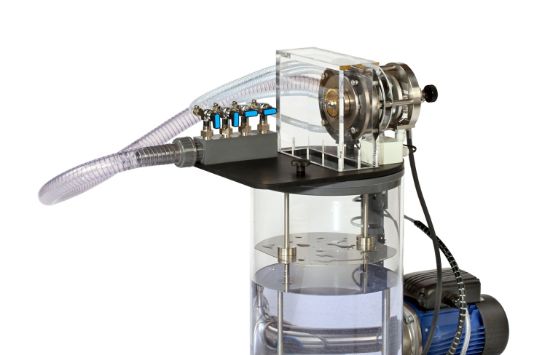Action turbines operate according to the principle of equal pressure. The static pressures at the inlet and at the outlet of the rotor are equal.
The experimental unit is placed upon the base unit HM 290. The two units together provide the basic experiments to get to know the operating behaviour and the most important characteristic variables of action turbines.
The water jets are discharged at high velocity from the four nozzles of the distributor. The water jets are deflected in the rotor and put it in motion. The axially discharged water from the rotor can be observed.
HM 291 consists of a rotor, mounted in a transparent housing, a distributor with four nozzles and a loading device outside of the housing. The number of active nozzles can be adjusted by valves. The eddy current brake generates a defined load. The eddy current brake is specially developed by GUNT. It is wear-free and can be finely adusted.
The torque delivered by the turbine is determined via an electronic force sensor. The speed is measured with an optical speed sensor. The measuring values are transferred to the base unit HM 290.
The water supply and the flow rate measurement are realised with the base unit HM 290. A pressure control included in HM 290 enables the recording of characteristics at a constant head.
All the advantages of software-supported experiments and evaluation are offered by the GUNT software in HM 290.

Experiments with an action turbine
Action turbines operate according to the principle of equal pressure. The static pressures at the inlet and at the outlet of the rotor are equal.
The experimental unit is placed upon the base unit HM 290. The two units together provide the basic experiments to get to know the operating behaviour and the most important characteristic variables of action turbines.
The water jets are discharged at high velocity from the four nozzles of the distributor. The water jets are deflected in the rotor and put it in motion. The axially discharged water from the rotor can be observed.
HM 291 consists of a rotor, mounted in a transparent housing, a distributor with four nozzles and a loading device outside of the housing. The number of active nozzles can be adjusted by valves. The eddy current brake generates a defined load. The eddy current brake is specially developed by GUNT. It is wear-free and can be finely adusted.
The torque delivered by the turbine is determined via an electronic force sensor. The speed is measured with an optical speed sensor. The measuring values are transferred to the base unit HM 290.
The water supply and the flow rate measurement are realised with the base unit HM 290. A pressure control included in HM 290 enables the recording of characteristics at a constant head.
All the advantages of software-supported experiments and evaluation are offered by the GUNT software in HM 290.
